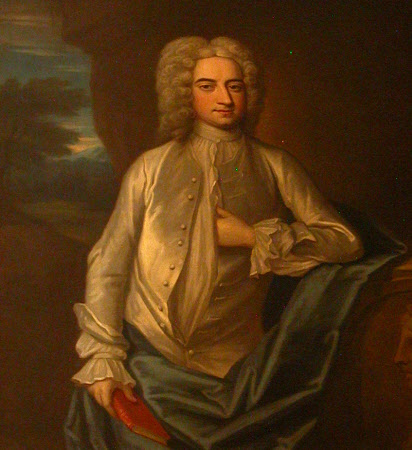The Hon. Thomas Hervey, MP (1699-1775)
John Fayram (fl. 1723 - 1743)
Category
Art / Oil paintings
Date
circa 1725 - 1730
Materials
Oil on canvas
Measurements
1245 x 991 mm (49 x 39 in)
Order this imageCollection
Ickworth, Suffolk
NT 851825
Caption
This is a portrait of the second son of the 1st Earl of Bristol by his second wife, Elizabeth Felton. Despite being described as an ‘eccentric man, whose mind was periodically unbalanced’, he sat as MP for Bury from 1733–47, and became Vice Chamberlain of Queen Caroline’s household. He caused a local scandal by eloping with the wife of a Suffolk neighbour, Sir Thomas Hanmer, whom he later attacked in a series of satirical pamphlets. According to Samuel Johnson, ‘Tom Hervey, though a vicious [means full of vice] man, was one of the genteelest men that ever lived’.
Summary
Oil painting on canvas, The Hon. Thomas Hervey, MP (1699-1775) by John Fayram (active c.1713–d.1744), circa 1725-1730. A three-quarter-length portrait of a man, in a powdered wig, wearing an ivory satin suit and a blue cloak, leaning with his left arm on a plinth, adorned with a laurel-crowned profile medallion, his left hand in his waistcoat, his right hand holding a red book. He has a fresh complexion and dark eyes. Landscape with trees and a distant horizon on the left. The second son of the 1st Earl of Bristol by his second wife, Elizabeth Felton. Despite being described as an ‘eccentric man, whose mind was periodically unbalanced’, he sat as MP for Bury from 1733–47, and became Vice Chamberlain of Queen Caroline’s household. He caused a local scandal by eloping with the wife of a Suffolk neighbour, whom he later attacked in a series of satirical pamphlets.
Provenance
Painted for the sitter’s father and thence by descent (probably in the London house) to the 4th Marquess (1863–1951), on whose death valued for probate by Christie’s; accepted by HM Treasury in lieu of tax and transferred to the National Trust in 1956
Credit line
Ickworth, The Bristol Collection (acquired through the National Land Fund and transferred to The National Trust in 1956)
Makers and roles
John Fayram (fl. 1723 - 1743)


